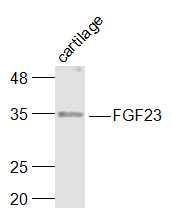产品货号 : mlR23556
英文名称 : FGF23
中文名称 : 成纤维细胞生长因子23抗体
别 名 : ADHR; FGF-23; Fgf23; FGF 23; FGF23_HUMAN; Fibroblast growth factor 23; Fibroblast growth factor 23 N-terminal peptide; Fibroblast growth factor 23 precursor; HPDR2; HYPF; Phosphatonin; PHPTC; Tumor derived hypophosphatemia inducing factor; Tumor-derived hypophosphatemia-inducing factor.
研究领域 : 肿瘤 细胞生物 免疫学 信号转导 干细胞 生长因子和激素
抗体来源 : Rabbit
克隆类型 : Polyclonal
交叉反应 : Mouse, Rat,
产品应用 : WB=1:500-2000 ELISA=1:500-1000 IHC-P=1:400-800 IHC-F=1:400-800 ICC=1:100-500 IF=1:100-500 (石蜡切片需做抗原修复)
not yet tested in other applications.
optimal dilutions/concentrations should be determined by the end user.
分 子 量 : 27kDa
细胞定位 : 分泌型蛋白
性 状 : Lyophilized or Liquid
浓 度 : 1mg/ml
免 疫 原 : KLH conjugated synthetic peptide derived from mouse FGF23:81-180/251
亚 型 : IgG
纯化方法 : affinity purified by Protein A
储 存 液 : 0.01M TBS(pH7.4) with 1% BSA, 0.03% Proclin300 and 50% Glycerol.
保存条件 : Store at -20 °C for one year. Avoid repeated freeze/thaw cycles. The lyophilized antibody is stable at room temperature for at least one month and for greater than a year when kept at -20°C. When reconstituted in sterile pH 7.4 0.01M PBS or diluent of antibody the antibody is stable for at least two weeks at 2-4 °C.
PubMed : PubMed
产品介绍 : This gene encodes a member of the fibroblast growth factor family of proteins, which possess broad mitogenic and cell survival activities and are involved in a variety of biological processes. The product of this gene regulates phosphate homeostasis and transport in the kidney. The full-length, functional protein may be deactivated via cleavage into N-terminal and C-terminal chains. Mutation of this cleavage site causes autosomal dominant hypophosphatemic rickets (ADHR). Mutations in this gene are also associated with hyperphosphatemic familial tumoral calcinosis (HFTC). [provided by RefSeq, Feb 2013]
Function:
Regulator of phosphate homeostasis. Inhibits renal tubular phosphate transport by reducing SLC34A1 levels. Upregulates EGR1 expression in the presence of KL. Acts directly on the parathyroid to decrease PTH secretion. Regulator of vitamin-D metabolism. Negatively regulates osteoblast differentiation and matrix mineralization.
Subunit:
Interacts with FGFR1, FGFR2, FGFR3 and FGFR4. Affinity between fibroblast growth factors (FGFs) and their receptors is increased by KL and heparan sulfate glycosaminoglycans that function as coreceptors.
Subcellular Location:
Secreted. Note=Secretion is dependent on O-glycosylation.
Tissue Specificity:
Expressed in osteogenic cells particularly during phases of active bone remodeling. In adult trabecular bone, expressed in osteocytes and flattened bone-lining cells (inactive osteoblasts).
Post-translational modifications:
Following secretion this protein is inactivated by cleavage into a N-terminal fragment and a C-terminal fragment. The processing is effected by proprotein convertases. O-glycosylated by GALT3. Glycosylation is necessary for secretion; it blocks processing by proprotein convertases when the O-glycan is alpha 2,6-sialylated. Competition between proprotein convertase cleavage and block of cleavage by O-glycosylation determines the level of secreted active FGF23.
DISEASE:
Defects in FGF23 are the cause of autosomal dominant hypophosphataemic rickets (ADHR) [MIM:193100]. ADHR is characterized by low serum phosphorus concentrations, rickets, osteomalacia, leg deformities, short stature, bone pain and dental abscesses. Defects in FGF23 are a cause of hyperphosphatemic familial tumoral calcinosis (HFTC) [MIM:211900]. HFTC is a severe autosomal recessive metabolic disorder that manifests with hyperphosphatemia and massive calcium deposits in the skin and subcutaneous tissues.
Similarity:
Belongs to the heparin-binding growth factors family.
SWISS:
Q9EPC2
Gene ID:
64654
Important Note:
This product as supplied is intended for research use only, not for use in human, therapeutic or diagnostic applications.
产品图片












